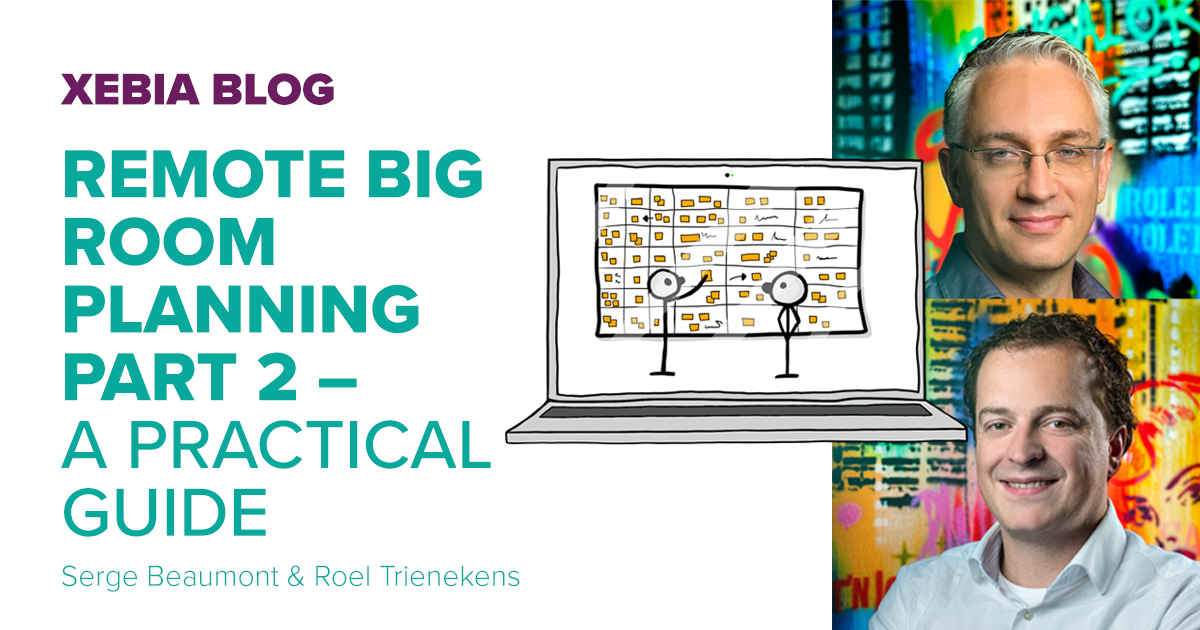In part 1 we explained what the toolkit required, and what you need to make your remote Big Room Planning a success. Today we will dive into more detail as we will guide you step by step through the organization of such an event, using the tools and applying the concepts we explained in part 1.

Prepare the Day
When you prepare your Big Room Planning, you need to make sure that:
- The common canvas is prepared and available to all.
- The common planning wall.
- Other overviews like team risk logs and parking lots.
- All the team backlogs available online for everyone, editable for the teams.
- All the channels.
- One common channel where the whole group meets.
- One facilitator channel as a back channel for facilitation.
- One channel per team for the breakout sessions.
- Depending on the tool, set up the correct rights (e.g. hosts and panelists in Zoom) in the relevant channels. Make sure that all URLs and/or locations are centrally published.
- The meeting structures documented and centrally published.
- All hosts and facilitators are available and knowledgeable with respect to the meetings.
Make sure that you prepare the technical side of your video conferencing software well in advance. And test it. For instance, when we hosted a large session with Zoom, we discovered that the single person who had scheduled all the meetings could not have multiple sessions live as host: as soon as he started another session, the one he was previously in shut down. It pays to test and check these things to make sure that the day goes smoothly.
To allow easy access to all information by everybody we have had very good experiences with tools that provide an 'infinite canvas' like Miro and Mural. This allows access to all information without having to switch tools.
For the large common sessions, just like in a webinar, you really need to have one or two people who keep an eye on the chat and Q&A, and moderate remarks and questions from there. We call this role a chat moderator. It’s almost impossible for a single speaking moderator or presenter to focus on presenting and deal with the side channels of information as well.
When preparing all of this, make sure that you inform the people that need to prepare their information (like backlogs) well in advance. Be specific in what structure, how and when this information will be used throughout the day.
Do the Day
Here’s an example of how such a day would go (we didn’t take any breaks into account here):
8:45
All channels go live, and people can connect and get ready.
9:00
Initial presentation by the overall Product Owner, communicating the product vision for the coming period. This is followed by a Q&A with the help of the chat moderators.
9:40
Break out sessions start. All teams switch to their team channel and start refining their Product Backlog for the coming period. During that time teams put items on specific boards (common canvases) of other teams to highlight possible conflicts, risks and issues to resolve. The Product Owners update the common planning wall as they go along.
Facilitators regularly come together in the Facilitators channel to discuss any issues encountered in the flow of the day itself.
12:00
Common session 2. Everybody goes to the common channel where the Product Owners (and any other team member assigned by that team) present their proposed Product Backlog for the coming period. To go through their risks, alignment issues and planning conflicts.
13:00
Break out sessions 2: All teams go back to their own channels and work on adapting their Product Backlogs, to deal with the raised issues. They mark them resolved (or not) on the relevant common canvases. Again team members may switch between channels to “visit” other teams and resolve issues.
15:00
Final common session: everyone comes together in the common channel, the Product Owners of each team present the resolved issues. A final Q&A follows with the help of the chat moderators.
15:30 End of day
After the session is over, take some time to wrap things up properly. Make sure all created artifacts are finished and made available to all participants. Send out a summary of the results of the day along with any open points that need to be picked by teams or individuals. And of course, reflect on the experience itself. What could we improve on next time? You don’t need to do this during the day, but don’t wait too long. As you want the experience to be fresh in everyone’s mind.
And most importantly, remember to have some fun. A day of remote Big Room Planning can be exhausting, so keep it light, make time for breaks and don’t be afraid to try out an energizer or two, either with the whole group or in the breakouts.
Conclusion
This new world in which many of us are working from home presents some new challenges, especially when it comes to things like the Big Room Planning that can give us some much needed room for alignment in these times of isolation. If you prepare, structure and facilitate the day well, the fully remote online Big Room Planning can be as effective as a physical one.
Let us help you with your Remote Big Room Planning.
Get in touch with us! Serge Beaumont and Roel Trienekens.


Want to learn more? Join the Scrum@Scaling, Certified SAFEe 5 Product Owner/Product Manager (SAFe PO/PM) or Certified SAFe 5 for Teams (SAFe SP) training online and use the virtual classroom as well. Our courses and locations have been aligned to support distance learning.




